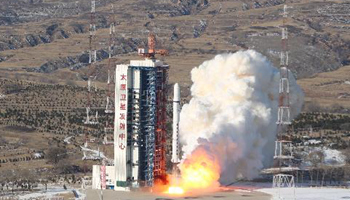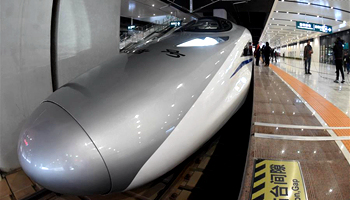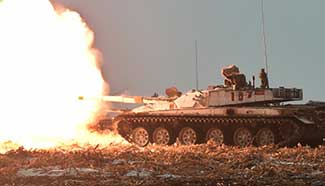by Peter Mertz
DENVER, the United States, Dec. 27 (Xinhua) -- America's aerospace industry was abuzz with excitement over a brash start-up company in the western state of Colorado, which declared it would soon offer trans-Pacific and Atlantic flights at supersonic speeds, a revived dream after Concorde.
Founded in 2014, Boom Technology's upcoming supersonic XB jet was designed to fly at Mach 2.2, namely 1,451 mph or about 2,335 km per hour, more than twice as fast as current commercial carriers.
"It's the supersonic revival," Erin Fisher, Boom Technology's head of Flight Control, whose team worked doggedly on a fully-operational test flight before the end of 2017, told Xinhua Tuesday.
Boom's engineers hoped to revive not only a dream but also an industry, which vanished in 2003 when the British-French supersonic Concorde carrier went belly up due mostly to cost overruns and inefficient design.
Concorde's service lasted 27 years before it disappeared into thin air a decade ago. However, people on the ground were not idle.
First, Boom got backing from aviation heavyweights and industrial giants Lockheed and Gulfstream. Then the new Silicon Valley company started recruiting the best and brightest supersonic minds it could find.
By March 2016, 11 of the country's top young aerospace engineers gathered in an airplane hangar just south of downtown Denver at the Centennial airport, in a bid to push Boom down the homestretch of revamping the supersonic industry forever.
Today, Boom's team has jumped to 28 innovative engineers and flight designers, who are building a streamlined supersonic jet that can carry 40 passengers from New York to London in 3.4 hours, and Los Angeles to Beijing in five hours.
"The Atlantic flight would allow the executive to have breakfast with his family, fly to London for a meeting, fly back in time to tuck his kids into bed," Boom said on its website.
While Concorde built only 20 jets in its history, Boom's ambitious initial production target was 1,300 jets. The company has taken orders for more than 30 jets already, and a major British carrier was considering another 170.
By 2023, when commercial flights are scheduled to begin, the company hopes to be in full-assembly mode with employment numbers in the "low thousands," according to Fisher.P "We've been talking to carriers across the world," Fisher said, but declined to comment on Boom's contact with China's three largest airlines -- China Eastern, China Southern, and Air China.
Boom's supersonic jets would be smaller than the 100-seat Concorde, and have been designed using cutting-edge computerized software.
The XB would be built and retro-fitted with new-age materials such as lightweight durable carbon-fiber composites, and its propulsion would come from three smaller and more efficient engines instead of the two blast furnaces Concorde employed.
At 200 million U.S. dollars, the jets would be cheap compared to the 339-million-dollar price tag of Lockheed Martin's F-22 Raptor. Coupled with dramatic cost reductions in research, design and production, most industry analysts have jumped on board the new wave.
"I have no problem seeing the demand for this airplane," Marty St. George, a JetBlue Airways executive, told Bloomberg.
Of all new improvements made to the flawed Concorde, none compares to the magnitude of Boom engineers using recently developed aeronautical computer design software called Computational Fluid Dynamics (CFD).
The CFD uses numerical analysis and algorithms to solve and analyze fluid flows. The applications are endless and the measurements precise. Young engineers love it because the CFD aeronautics software is a recent development of which they are familiar.
In airplane design, an aerodynamics engineer using a computer could run 1,000 simulated tests a week with tremendous accuracy, whereas 30 years ago, wind tunnel testing allowed only a few tests a week. The time saved in research and development is staggering.
Fisher said Boom had cut costs across the board, from research and development to testing and production, noting that material and engine retrofit expenses had been analyzed and streamlined.
In total, Boom said it was offering a giant, technological leap forward in the aeronautics industry. Moreover, the per passenger cost would be more efficient.
"The ticket cost will be half of what the Concorde charged, around 2,000 dollars per passenger," Fisher said, adding that most of Boom's investors had been American or European.
John Yee, a 95-year-old retired history professor at University of Colorado, said the company has perhaps not realized the potential for business in China.
"Their (the Chinese) business culture -- based on face-to face meetings and personal contact -- is perfect for Boom's supersonic concept," he said.
Yee, also a veteran of the famous Flying Tigers jet fighters squadron during World War II, was sent to the United States in 1944 to learn advanced aviation fighting techniques.
"The idea of crossing the Pacific Ocean in five hours is just mindboggling to someone of my generation," he said.
Patrick McCart, a Denver blogger, echoed Yee's thoughts.
"I cannot believe how many people think that teleconferencing or Skyping is even remotely the same as actually being there," he wrote. "No wonder the robots are going to take over."










